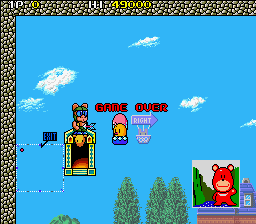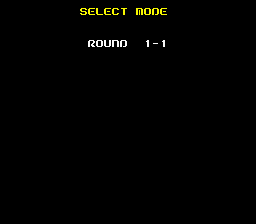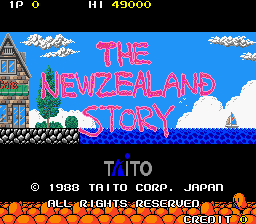The NewZealand Story (Arcade)
| The NewZealand Story |
|---|
|
Developer: Taito
|
The NewZealand Story continues the proud Taito tradition of cute characters in maddeningly difficult games.
| To do: There are a lot of regional/revisional differences, as well as a location test prototype. |
Contents
Kumagaya Easter Egg

Taito Kumagaya Laboratory developed this game; the proof of this is a hidden company logo in the attract mode. To see it, wait for a demo to start playing, then press 1P Button 1 3 times.
Round Select

Hold the Service Coin button (MAME default 9), then do a soft reset (MAME default F3). Once SERVICE SW ERROR shows up, let go of the Service Coin button and press P1 Insert Coin, P1 Insert Coin, P1 Insert Coin, Service Coin, P1 Insert Coin (MAME defaults 1, 1, 1, 9, 1). You will be taken to a round select also used in Chuuka Taisen and Insector X.
The code works in all versions of the game, but any selections past Level 5-4 will either take you to a bonus stage or dump you into a glitched, unplayable map.
Unused Graphics
Tiki

This animation should be used when throwing bombs, but it isn't. Oh well.
Key
![]()
The only power-up that doesn't appear in the game. Its use can only be guessed at. One possibility is that they were meant to be collected to be used on the cages in order to complete the levels, as that idea would eventually resurface 19 years later in NewZealand Story Revolution for Nintendo DS.
Unused Enemy + Vehicle
![]()
![]()

An odd little enemy that appears to be riding a jet pack! It never spawns in the game (even from the Wizard), so both the enemy and the vehicle are unused.
However, in the "World, prototype?" version of the game, using the Round Select code detailed below and selecting Round 4-2 (as this version of the game ends at 4-1) takes you to a playable if unfinished map (shown in the video above) where this enemy will spawn! It cannot be killed, flies around in a vague S-shape pattern, and will kill Tiki on contact, just like the spike enemies.
Heaven Tiles
![]()
These tiles are loaded with the Heaven tileset, but they don't appear in those levels.
References
Cleanup > Pages missing developer references
Cleanup > Pages missing publisher references
Cleanup > To do
Games > Games by content > Games with hidden level selects
Games > Games by content > Games with unused enemies
Games > Games by content > Games with unused graphics
Games > Games by content > Games with unused items
Games > Games by developer
Games > Games by developer > Games developed by Square Enix > Games developed by Taito
Games > Games by platform > Arcade games
Games > Games by publisher
Games > Games by publisher > Games published by Square Enix > Games published by Taito
Games > Games by release date > Games released in 1988
Games > Games by release date > Games released in September
